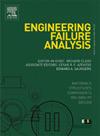Failure analysis of in-service Type-II CNG cylinders from composite part damaged by hexagon flange bolt
IF 5.7
2区 工程技术
Q1 ENGINEERING, MECHANICAL
引用次数: 0
Abstract
This paper investigated the failure of in-service Type-II compressed natural gas (CNG) cylinders whose composite parts were damaged by contact with hexagon flange bolts, i.e., clamp bolts, in buses. Eighteen Type-II CNG cylinders that had been in service for 7–10 years were examined: mechanical tests and chemical analysis were conducted on 12 cylinders; extreme temperature cycling tests on 4 cylinders; ambient temperature cycling tests on 2 cylinders. The results showed that pre-existing damage of composite part increased in size under cyclic pressurization, and cylinders with severe composite defects eventually ruptured. These experiments confirmed that the interference from hexagon flange bolts, leading to damage of the composite part is a critical safety hazard. It is recommended that clamp attachment bolts should be redesigned or installed with sufficient clearance, e.g. a smaller-head hexagon bolt and a washer, to avoid contact with the cylinder, and that periodic re-inspections be mandated to detect composite damage before catastrophic failure occurs.
在役ii型CNG气瓶复合件内六角法兰螺栓破坏失效分析
本文研究了在役型压缩天然气(CNG)气瓶复合部件与客车内六角法兰螺栓(即夹紧螺栓)接触而损坏的失效问题。对服役7-10年的18个ii型CNG气瓶进行了检查:对12个气瓶进行了力学测试和化学分析;4个气缸极端温度循环试验;2个气缸环境温度循环试验。结果表明:在循环增压作用下,复合材料零件的预存损伤尺寸增大,存在严重复合材料缺陷的气瓶最终破裂;这些试验证实了六角法兰螺栓的干涉导致复合材料零件的破坏是一个严重的安全隐患。建议重新设计夹紧螺栓或安装有足够间隙的夹紧螺栓,例如,小头六角螺栓和垫圈,以避免与气缸接触,并要求定期重新检查,以便在发生灾难性故障之前发现复合损伤。
本文章由计算机程序翻译,如有差异,请以英文原文为准。
求助全文
约1分钟内获得全文
求助全文
来源期刊

Engineering Failure Analysis
工程技术-材料科学:表征与测试
CiteScore
7.70
自引率
20.00%
发文量
956
审稿时长
47 days
期刊介绍:
Engineering Failure Analysis publishes research papers describing the analysis of engineering failures and related studies.
Papers relating to the structure, properties and behaviour of engineering materials are encouraged, particularly those which also involve the detailed application of materials parameters to problems in engineering structures, components and design. In addition to the area of materials engineering, the interacting fields of mechanical, manufacturing, aeronautical, civil, chemical, corrosion and design engineering are considered relevant. Activity should be directed at analysing engineering failures and carrying out research to help reduce the incidences of failures and to extend the operating horizons of engineering materials.
Emphasis is placed on the mechanical properties of materials and their behaviour when influenced by structure, process and environment. Metallic, polymeric, ceramic and natural materials are all included and the application of these materials to real engineering situations should be emphasised. The use of a case-study based approach is also encouraged.
Engineering Failure Analysis provides essential reference material and critical feedback into the design process thereby contributing to the prevention of engineering failures in the future. All submissions will be subject to peer review from leading experts in the field.
 求助内容:
求助内容: 应助结果提醒方式:
应助结果提醒方式:


